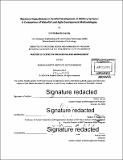| dc.contributor.advisor | Nelson P. Repenning. | en_US |
| dc.contributor.author | Garcia, Erik Roberto | en_US |
| dc.contributor.other | System Design and Management Program. | en_US |
| dc.date.accessioned | 2016-11-14T19:05:39Z | |
| dc.date.available | 2016-11-14T19:05:39Z | |
| dc.date.copyright | 2014 | en_US |
| dc.date.issued | 2014 | en_US |
| dc.identifier.uri | http://hdl.handle.net/1721.1/105297 | |
| dc.description | Thesis: S.M. in Engineering and Management, Massachusetts Institute of Technology, Engineering Systems Division, 2014. | en_US |
| dc.description | DVD-ROM contains supplemental models: four .mdl files and two .vdf files. | en_US |
| dc.description | Cataloged from PDF version of thesis. | en_US |
| dc.description | Includes bibliographical references (pages 63-64). | en_US |
| dc.description.abstract | The United States Department of Defense has been plagued with failing programs that are over budget, behind schedule, and exhibit poor performance during testing. Once a program has cost, schedule, or capability issues, follow-on development efforts adopt the underlying issues only to reinforce poor performance. To address these issues that lead to firefighting, one option is to use an Agile software development process to introduce capabilities earlier in the development process for effective testing. Two System Dynamics models compare Agile with the traditional Waterfall development approach to determine: if Agile development reduces the conflict between cost, schedule, and capability constraints; if Agile development reduces firefighting; and will Agile development impact other development tasks. Based on the simulation of each model, Agile did improve the dynamics of parallel development cycles by maximizing the productivity of the entire development team. Under the same System and Software Engineering team size and development release schedule, Agile development increases the quantity of requirements introduced within a development cycle. However, Agile development emphasized less on maturing new technologies leading to considerably less innovative builds. Thesis Supervisor: | en_US |
| dc.description.statementofresponsibility | by Erik Roberto Garcia. | en_US |
| dc.format.extent | 64 pages | en_US |
| dc.language.iso | eng | en_US |
| dc.publisher | Massachusetts Institute of Technology | en_US |
| dc.relation.requires | System requirements: Windows and DVD-ROM drive. | en_US |
| dc.rights | M.I.T. theses are protected by copyright. They may be viewed from this source for any purpose, but reproduction or distribution in any format is prohibited without written permission. See provided URL for inquiries about permission. | en_US |
| dc.rights.uri | http://dspace.mit.edu/handle/1721.1/7582 | en_US |
| dc.subject | Engineering Systems Division. | en_US |
| dc.subject | System Design and Management Program. | en_US |
| dc.title | Resource dependencies in parallel development of military systems : a comparison of waterfall and agile development methodologies | en_US |
| dc.type | Thesis | en_US |
| dc.description.degree | S.M. in Engineering and Management | en_US |
| dc.contributor.department | System Design and Management Program. | en_US |
| dc.contributor.department | Massachusetts Institute of Technology. Engineering Systems Division | |
| dc.identifier.oclc | 962306052 | en_US |
